This was published 6 years ago
Kyoto Railway Museum: The biggest train museum in Japan
By Anthony Dennis
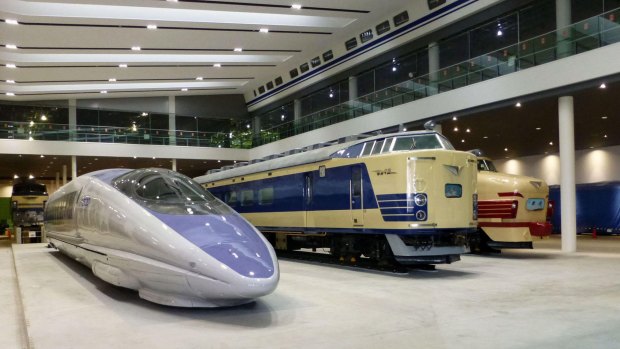
Around 50 trains are on display at Kyoto Railway Museum.Credit: Alamy
When it was recently revealed that an official and abject apology had been issued for a train in Japan having departed a station 20 seconds early, the international reaction was one of understandable wonderment and incredulity. What would the reaction had been had the train been late?
Japan's rail system, as anyone who has experienced it would be aware, prides itself on obsessive levels of punctuality and courtesy unmatched anywhere in the world. When departing each carriage immaculately attired conductors unfailingly ritually bow as a sign of respect to passengers, admittedly some of whom are likely to have their heads buried in often lurid manga comics.
Train travel in Japan is as ingrained in the culture as much as sushi, sake and sumo. Few days in the life of a Japanese person do not feature a train, whether they be commuting for work, travelling for pleasure, or even standing or sitting in one spot since in crowded Japan a train and a train line is never far away.
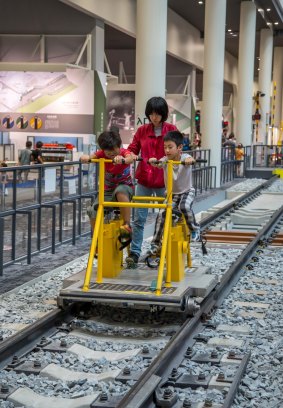
Children ride a handcar at Kyoto Railway Museum in Japan.Credit: Alamy
Ensuring that the Japanese retain an unstinting confidence in its railways as a means of dependable conveyance and for providing a kind of societal adhesive can go some way to explaining why its operators are so fixated on its continuing near-impeccable record for safety, efficiency and punctuality.
Aside from actually travelling by train in Japan, whether that be aboard the renowned shinkansen, meaning trunk line or more commonly bullet train, or even just a standard local service, you need to journey to Kyoto for the next best way to understand the profound place that railways occupy within Japanese society and its complex, at times impenetrable, national psyche. There you'll find what might well represent the world's finest railway museum.
The Kyoto Railway Museum is located in Shimogyo-ku, one of the 11 wards of Japan's former ancient capital. It was originally the Umekoji Steam Locomotive Museum, which opened in 1972. The institution, which is owned and operated by the West Japan Railway Company (JR-West), part of the massive Japan Railways group, was dramatically expanded last year, rendering it the biggest train museum in Japan, with its displays featuring shiny, mint-condition bullet trains.
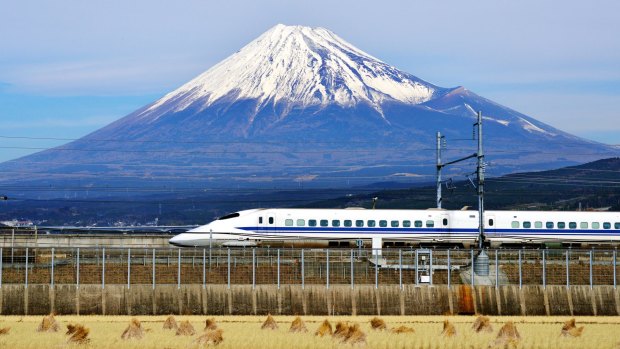
A bullet train passes below Mt. Fuji in Japan.Credit: Alamy
Kyoto itself, like most big Japanese cities, has an abiding relationship with trains. The gargantuan Kyoto Station, which turned 20 earlier this year, is not just an important terminal for arriving and departing locals and visitors, it's also a major and dominant landmark and architectural statement, a virtual small town with its own five-star hotel, a major upscale department store and a range of restaurants, cafes and shops.
Fitting, then, that Kyoto should host such a museum celebrating the role of the train in Japanese society. Frankly, most railway museums around the world are run by enthusiastic, if not obsessive, overall-clad and aged train-spotting volunteers with an unfailing focus on the steam age. But the Kyoto Railway Museum couldn't be any more distinct with those bullet trains taking pride of place in the vast main exhibition hall. Then there's memorabilia including an exhaustive display of what appears to be every book and film written and made about train travel in Japan.
Yet it's the shinkansen, with its maximum operating speeds of 320 kilometres an hour, that rightly remains at the heart of the museum and its main attractions. It was this revolutionary train, after all, with its record-breaking speeds that in 1964, along with the Tokyo Olympics, led Japan's global re-emergence following the horrors and ignominies of World War II.
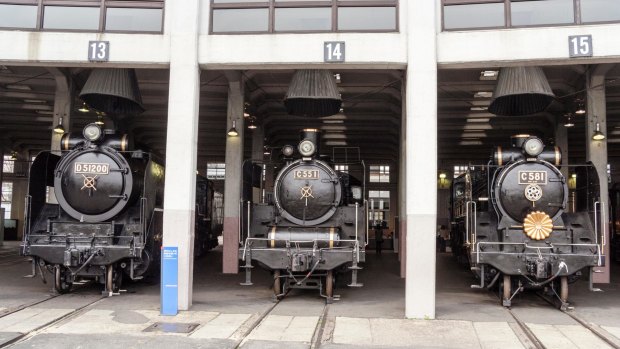
Umekoji Steam Locomotive Museum.Credit: Alamy
It provided the country with an instant icon, especially when juxtaposed shooting past the monumental and sacred Mount Fuji. One of the original series shinkansen, among others, is on display at the museum and it still looks nearly as modern as the day it was commissioned.
Although the technology behind bullet trains has been copied around the world, most notably by the Chinese who now boast the world's biggest network of high-speed trains and, at 370 million passengers a year the biggest patronage, the singular quality and enjoyment of everyday train travel in Japan remains unsurpassed.
Aside from the impressive new main three-storey building, the museum also features The Roundhouse, an imposing locomotive shed built around a vast turntable and which is designated by the Japanese Government as an Important Cultural Property. From near here visitors to the museum can also take short vintage steam train rides along a specially designated track that runs along a public park.
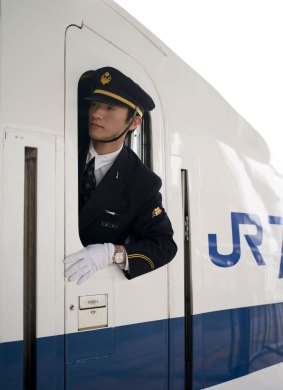
Shinkansen Bullet train conductor checks the platform as the train pulls out of Osaka station bound for Tokyo.Credit: Alamy
Nearby is a traditional Japanese-style two-storey station building that once formed the entrance to the more modest original museum and which today houses the institution's well-patronised souvenir shop. It provides an attractive contrast to the contemporary design of the new main building from the open-air Sky Terrace, from which visitors can observe bullet trains, as well as other services, sweeping in and out of Kyoto. It's a thrilling sight, even if you aren't a train fancier, with barely a second passing before another train, well, passes.
Before lunch in the museum's cafe (so efficient, large and hygienic, it reminds me of an Ikea cafeteria –and the rice is served in the shape of a locomotive), I'm invited to test my skills on one of the museum's train simulators.
Such is the popularity of the shinkansen simulators that a daily lottery has to be held for the right to access to them. I end up on an ordinary local train simulator, having declined the offer to don a driver's cap and coat from a wardrobe full of them.
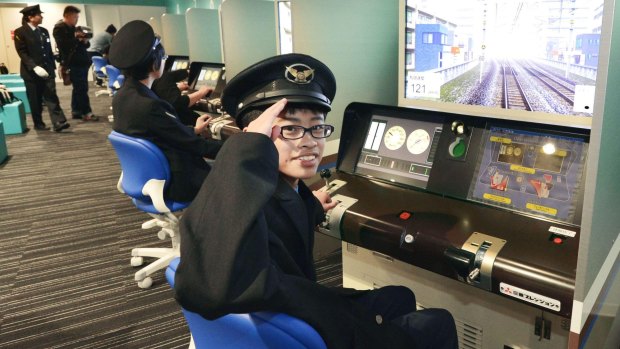
A boy takes a turn on a driving simulator, used by professional train drivers for training, at the Kyoto Railway Museum in Kyoto.Credit: Alamy
Eventually, after a series of embarrassing platform over-shoots and some gratuitous use of the train whistle, I feel almost compelled to issue one of those Japanese-style public apologies. Instead I shrink away, headed for the cafeteria for a lunch of moulded loco rice and sausages.
FIVE MORE WAYS TO ENJOY TRAIN TRAVEL IN JAPAN
BUY A JAPAN RAIL PASS
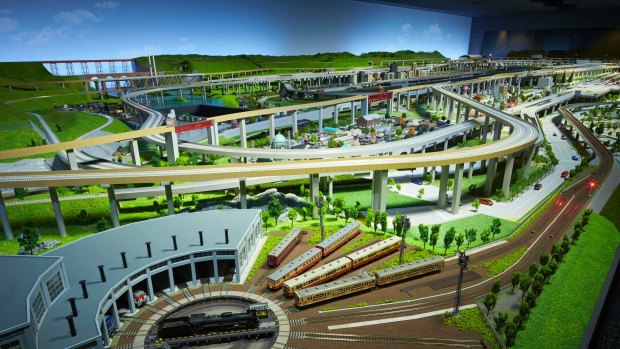
Train travel in Japan is as ingrained in the culture as sushi, sake and sumo.
Still one of the world's best travel bargains, the Japan Rail Pass allows access to a huge range of train services, except for the most express shinkansen. The pass is best organised and bought in Australia and validated in Japan as close as possible to your first train departure to maximise its value.
HANG AROUND THE STATIONS
In most countries, such as those in Europe, it's advisable to exit major train stations as soon as possible, lest you be robbed or molested. But in Japan stations, including the main facility in Kyoto, as large and overwhelming as they can be, you'll find plenty of mostly excellent and affordable places to eat and drink as you rub shoulders with local commuters.
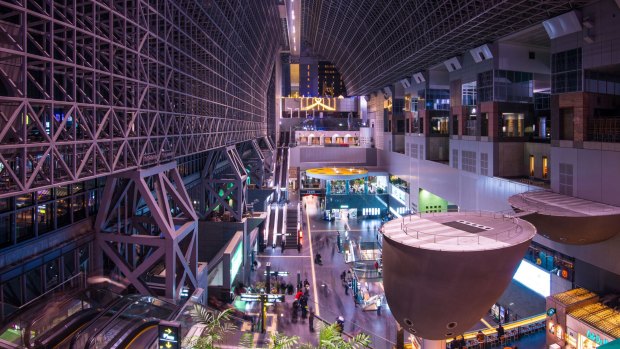
Kyoto Station: Japan's second-largest station building.Credit: Alamy
GRAB A BENTO BOX
Few if any Japanese trains have dining cars or even cafeterias, with the Japanese relying on delicious packaged bento box meals bought at stations, on platforms or from sweet-voiced female attendants who pass through the train with carefully stacked trolleys. Each bento tends to be reflective of its local region with the ingredients prepared fresh daily.
PACK CAREFULLY
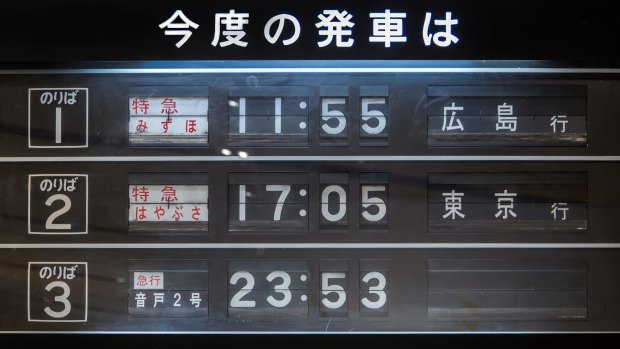
Kyoto Railway Museum, opened in 1972, is the largest railway museum in Japan.Credit: Alamy
Japanese trains are not designed for luggage storage, with most locals travelling lightly with overnight bags for short trips. It can be a good idea, therefore, to not only avoid hefty pieces of luggage but also to try and be among the first to board your carriage to secure what little space is available (if the luggage rack is full try the space under the last seats at the rear of the carriage).
LOOK OUT FOR MOUNT FUJI
A good many visitors to Japan travel on the route between Kyoto and Tokyo, and vice versa. On clear days it is possible to view sacred Mount Fuji in all its snow-capped conical glory as you pass, even on a high-speed bullet train, so be sure not to nod off at the crucial point.
TRIP NOTES
VISIT
The Kyoto Railway Museum is open 10am to 5.30pm. It is closed on Wednesdays and part of Tuesdays, except for public holidays, and between December 30 and January 1. Admission is JPY1200 for adults and JPY500 for children, depending on their age group. See kyotorailwaymuseum.jp/en/
FLY
ANA (All Nippon Airways) operates daily flights from Sydney to Tokyo's popular Haneda Airport with regular domestic connections to Kansai Airport, which services Kyoto and Osaka. See ana.co.jp
TOUR
With its knowledgeable and experienced English-speaking guides based in Japan, Experience Japan Travel can tailor a wide variety of holidays throughout Japan to suit all travel styles and specific interests, including in-depth visits to Kyoto. See experiencejapantravel.com
STAY
The boutique-like 134-room Ritz Carlton Kyoto is located besides the Kamo-gawa River and close to major attractions such as Pontocho, a historic laneway frequented by geisha. Elsewhere, Iori Machiya Stay offers self-contained, luxuriously appointed traditional townhouses throughout central Kyoto. If you fancy staying inside Kyoto Station itself, consider the 536-room Hotel Granvia Kyoto. Platforms for arriving and departing trains are a short stroll from the hotel's lobby. See ritzcarlton.com/Kyoto; kyoto- machiya.com; granviakyoto.com
MORE
Anthony Dennis visited Kyoto as a guest of Visit Kyoto, ANA (All Nippon Airways) and Experience Japan Travel.
Sign up for the Traveller Deals newsletter
Get exclusive travel deals delivered straight to your inbox. Sign up now.